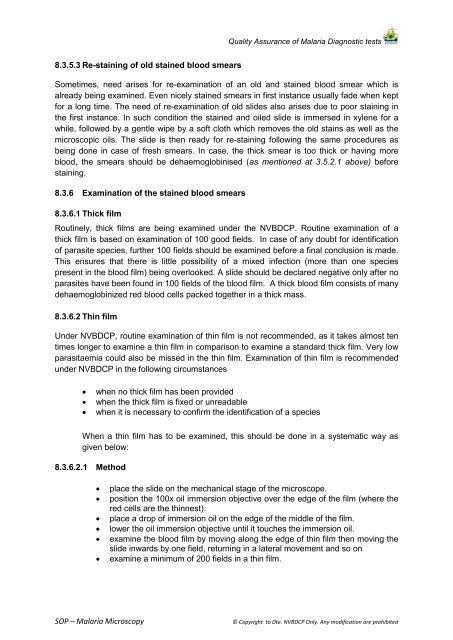SOP â Malaria Microscopy - NVBDCP
SOP â Malaria Microscopy - NVBDCP
SOP â Malaria Microscopy - NVBDCP
You also want an ePaper? Increase the reach of your titles
YUMPU automatically turns print PDFs into web optimized ePapers that Google loves.
Quality Assurance of <strong>Malaria</strong> Diagnostic tests8.3.5.3 Re-staining of old stained blood smearsSometimes, need arises for re-examination of an old and stained blood smear which isalready being examined. Even nicely stained smears in first instance usually fade when keptfor a long time. The need of re-examination of old slides also arises due to poor staining inthe first instance. In such condition the stained and oiled slide is immersed in xylene for awhile, followed by a gentle wipe by a soft cloth which removes the old stains as well as themicroscopic oils. The slide is then ready for re-staining following the same procedures asbeing done in case of fresh smears. In case, the thick smear is too thick or having moreblood, the smears should be dehaemoglobinised (as mentioned at 3.5.2.1 above) beforestaining.8.3.6 Examination of the stained blood smears8.3.6.1 Thick filmRoutinely, thick films are being examined under the <strong>NVBDCP</strong>. Routine examination of athick film is based on examination of 100 good fields. In case of any doubt for identificationof parasite species, further 100 fields should be examined before a final conclusion is made.This ensures that there is little possibility of a mixed infection (more than one speciespresent in the blood film) being overlooked. A slide should be declared negative only after noparasites have been found in 100 fields of the blood film. A thick blood film consists of manydehaemoglobinized red blood cells packed together in a thick mass.8.3.6.2 Thin filmUnder <strong>NVBDCP</strong>, routine examination of thin film is not recommended, as it takes almost tentimes longer to examine a thin film in comparison to examine a standard thick film. Very lowparasitaemia could also be missed in the thin film. Examination of thin film is recommendedunder <strong>NVBDCP</strong> in the following circumstances• when no thick film has been provided• when the thick film is fixed or unreadable• when it is necessary to confirm the identification of a speciesWhen a thin film has to be examined, this should be done in a systematic way asgiven below:8.3.6.2.1 Method• place the slide on the mechanical stage of the microscope.• position the 100x oil immersion objective over the edge of the film (where thered cells are the thinnest).• place a drop of immersion oil on the edge of the middle of the film.• lower the oil immersion objective until it touches the immersion oil.• examine the blood film by moving along the edge of thin film then moving theslide inwards by one field, returning in a lateral movement and so on• examine a minimum of 200 fields in a thin film.<strong>SOP</strong> – <strong>Malaria</strong> <strong>Microscopy</strong>© Copyright to Dte. <strong>NVBDCP</strong> Only. Any modification are prohibited
















